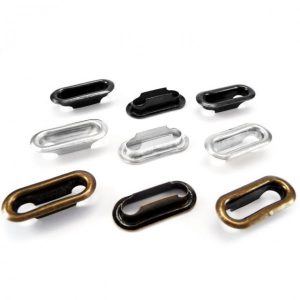(ThyBlackMan.com) You can add subtle elegance to your apparel with decorative items such as an oval eyelet. This metal accessory can be used on footwear, leather goods and clothing. Other accessories that can enhance your attire include rivets, buckles, cords, chains, wire and buttons. Here are ways that such metal items can add a touch of class to your professional appearance and belongings.
Purpose of Eyelets
An eyelet is merely a smaller version of a grommet, which is a useful ring-shaped fastener for hanging shower curtains. It has both utility and aesthetic value. An eyelet is a small round hole in clothing for threading a lace or string through the opening. Eyelets are actually used for many different products beyond clothing, such as tools. They are familiar to most people since they’re what shoelaces go through on shoes.
While eyelets work as rivets, they are more adaptable and can be used for multiple items such as appliances, electrical circuits and lamps. A rivet has a protruding head on one end, whereas eyelets have tubing completely through the diameter without protrusions. Copper rivets are commonly used on jeans to hold the fabric  together, but mainly as a fashion statement, especially on designer jeans. The round hole of the eyelet allows for various types of fasteners, making it a more flexible choice. It’s also usually a lightweight solution.
together, but mainly as a fashion statement, especially on designer jeans. The round hole of the eyelet allows for various types of fasteners, making it a more flexible choice. It’s also usually a lightweight solution.
One of the main reasons to use eyelets is to add strength and protection to an item and to protect holes from wear and tear. These small attachments do not cost much and exhibit a flexible design. The main two parts of the object are the barrel and the flange. A barrel is what attaches to a material, whereas the flange provides an additional grip. There are various types of flanges, depending on the material being fastened. Eyelets in general come in many different sizes. Typical standard diameter hole sizes range from 1/16 to 3/16 inches.
Where You’ll Find Eyelets Beyond Clothing
- custom designs
- collars
- closures
- cans and canisters
- handbags
- industrial components
- jewelry
How Eyelets are Made
Like so many manufactured products these days, eyelets are designed with state-of-the-art 3D software. The material used for these objects is usually metal, but can also be made with carbon fiber, wood, plastic, gemstone or honeycomb. Brass or iron are common metals that stand out as design features. Machines used to make eyelets are hand pressing tools capable of punching holes through metal. Eyelets first became popular in the nineteenth century with the advent of machines designed to manufacture them.
Eyelet Installation
The best way to assure you have enough eyelets for a project is to purchase a kit that comes with tools to help put them together. If the eyelet is placed on thin enough material, you can use eyelet pliers to make the job easier. When using a fabric pattern, there’s usually an indicator or round symbol on the pattern where the eyelet should be placed. It helps to mark the fabric with a small dot where the eyelet will be installed.
The dot is where you will cut a hole that is big enough to allow the center section of the eyelet to push through the material. Precision cutting is important and can be done with scissors, but it’s imperative that the hole you cut is not too big and is smaller than the diameter of the eyelet. Starting with a small “x” shape is an effective way to initiate the hole in the fabric. The top of the eyelet fits into the hole while the bottom of the eyelet fits over the top portion as a fastener. It helps to work on a flat surface as you place a tool known as a “tower” over the object and lightly tap it with a hammer until the parts are securely connected.
Conclusion
Eyelets, grommets and rivets can turn regular fabric into art. These circular objects can make sweaters, pants and jackets more fashionable. The blend of soft fabric and hard metal can particularly be eye-catching. The shiny appearance can add mirror-like imagery to an atmosphere. Consider these products to exhibit a greater sense of energy and confidence.
Staff Writer; Karl Jones

















Leave a Reply